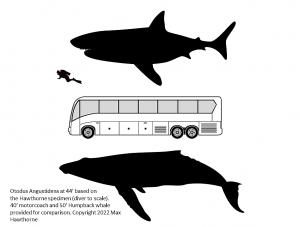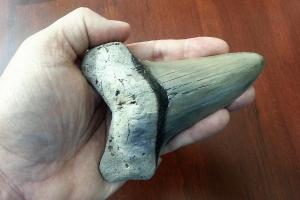An Ancestor of The Megalodon Shark Was Bigger Than People Think
New fossil evidence suggests that Otodus angustidens, the ancestor of the famous Megalodon shark or “Meg”, also grew to enormous size.
Bestselling author and avocational paleontologist Max Hawthorne is poised to answer this question. Known best for his Kronos Rising series of “paleo-fiction” novels, Hawthorne has published numerous paleontological theories, including one that appears to have solved the mystery of why many Mesozoic plesiosaurs evolved such long necks, using observations of snake neck turtles feeding on fish to bolster his arguments. He also published a piece that indicates Megalodon may have been even larger than once thought, and in his research book Monsters & Marine Mysteries, investigated huge shark bites on modern whales to determine if there really are any Jaws-sized (or bigger) sharks still out there.
A consummate fossil collector, Hawthorne has acquired a huge Angustidens tooth that appears to indicate the species grew far larger than the estimated 31’ currently listed on Wikipedia. That specimen’s largest tooth measures 3.89 inches diagonally. Using his previous Megalodon research methods, Hawthorne attempted to assess the size of his tooth’s former owner.
“Angie, as I fondly refer to her, is a lower jaw tooth and measures a full 4.8 inches in slant height,” Hawthorne stated. “However, based on root shape and crown angle, she was not the largest or anterior-most tooth in the jaw. I calculate her position at being number three, or LL3, meaning lower left, third position.” He went on to explain how, using known facts, he was able to number crunch and figure out how big the largest tooth in the shark’s jaw was, with the hope of using that to extrapolate its overall size.
“Angie was an ancestor and close relative of Megalodon,” Hawthorne continued. “And since we have the stats on several complete sets of Megalodon jaws, I opted to use one of those for comparison. In this case, it was CB-11, the larger of the two, which was very similar in size. For starters, I compared Angie to the two #3 teeth in the lower jaw of CB-11. They were 129mm (long) x 82mm (wide) for 3L and 123mm x 86mm for 3R. Angie measures 122mm x 86mm, but her robust crown shows a bit of compression damage at the tip from feeding, and could easily have been 2mm larger. Which means, in terms of both length and width, it’s in the same size range as that of the Megalodon. In fact, size-wise, the 3R tooth is a veritable twin. This tells us that not only did both specimens have similar-sized teeth, their bite width and jaw size was probably similar as well.”
When asked how that helped calculate the size of his shark, the author replied, “Based on this, it’s likely that, despite the crowns changing shape from the older species to the younger, overall tooth size was similar. So, we can infer then that the largest tooth in ‘Angie’s’ mouth was probably around the same size as CB-11’s largest, or 146mm (5.75 inches).” Hawthorne then went on to explain how he was able to use traditional tooth crown formulas to estimate length. “My tooth is about 77% crown. Applying those proportions to a max tooth size of 5.75 inches, that suggests a shark measuring some 44 feet in length. It also suggests that the most complete Angustidens specimen, the New Zealand one, measured 30 feet when alive. That’s only a foot from the listed estimate of 31 feet with a max tooth size of 3.89 inches, which I find reassuring. Interestingly, if I take that 3.89” tooth size and scale up a max of 5.75” – an increase of 48% – I get a shark measuring ~46’ in length (based on a 31’ specimen) and ~44’ if the NZ specimen was only 30’ in length. Again, although the numbers are rough, we’re definitely in the ballpark.”
In summation, Hawthorne said, “What that ultimately means is that we can say with a good deal of confidence that the ‘Oligocene Annihilator’, as I like to refer to Otodus angustidens, once grew to the size of an adult humpback whale. With the biggest whales back then belonging to a family called the Aetiocetidae, which maxed out at 26’, and were basically baleen whales with teeth, Angie would have been the apex predator of her day. Her kind swam the seas for over ten million years, and her descendants would one day culminate in the infamous Megalodon shark, one of the largest flesh eaters of all time. We should be glad they’re gone, as we’d be little more than slow-swimming potato chips, sharing the water with these mammoth predators.”
Kevin Sasaki
Media Representative
+1 310-650-3533
email us here
Visit us on social media:
Facebook
Twitter
Other
Legal Disclaimer:
EIN Presswire provides this news content "as is" without warranty of any kind. We do not accept any responsibility or liability for the accuracy, content, images, videos, licenses, completeness, legality, or reliability of the information contained in this article. If you have any complaints or copyright issues related to this article, kindly contact the author above.



